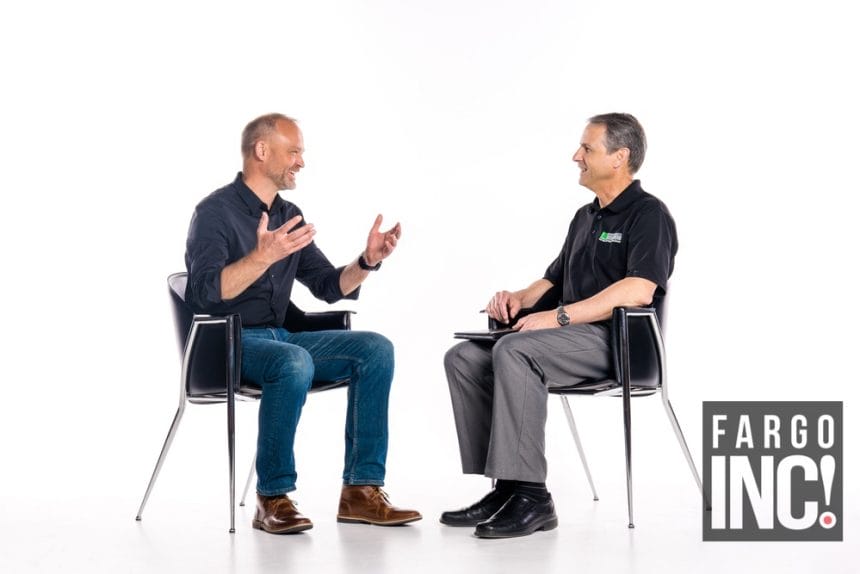Photos by Hillary Ehlen
Every business owner has been at the point where they’ve reached their capacity. As a sole-owner and the only employee, you can’t grow anymore on your own. So how do you scale? That’s the point that Ole Rygg, the founder of Corporate Elements, has found himself in.
To help answer his questions about growth and hiring employees, we had him sit down with Paul Smith the Fargo Center Director for the ND Small Business Development Centers.
Business Owner
Ole Rygg
Founder of Corporate Elements
Financial Expert
Paul Smith
Fargo Center Director for the ND Small Business Development Center
The Conversation
Ole: I’m in a situation where I cannot do everything for every organization out there. So I’m looking to hire some people or contracting other facilitators who are really skilled at what they do.
Paul: You mean you can’t scale yourself (laugh)?
Ole: Well, I can’t duplicate myself, but I have a unique story and background and strengths. It is hard to be everything for everyone.
Paul: I would ask, what is your vision for the company? How much of what you do depends on the unique skills and attributes you bring to the table? How challenging will it be for you to recruit others to execute your plan? Do you have a method and process which can be clearly communicated, trained and implemented so there is some consistency in how your services are delivered regardless of the facilitator and coach?
Ole: You’re absolutely right. That’s what I learned early. I was meeting with people and asking them, what’s keeping you up at night? How can I help you? What’s your plan? And I would customize something to that situation. I’ve learned over the years, slowly but surely, to use more off the shelf resources so I’m working with a number of vendors.
Ole: But that’s a great question because that was something I got stuck in before.
Paul: I think it’s critical to step back and ask some difficult questions which every business plan should address: What problems does my business solve? How does it solve those problems in a way that’s different from others? What is your ideal client profile? Which types of companies do you want to work with? Which clients or work would you say “no” to? What’s my long-term vision for the business?
Ole: I’m looking for people who want to improve their results and have been trying different methods but haven’t been able to implement anything structured. So this is something that can be customized to an organization’s structure, policies and systems. I have the experience and the methodology to make a difference, to make learning work and to help people learn not to do training per se because the individual training that people get right now is very fragmented.
Ole: What are some best practices for hiring 1099 contractors? That scares me a little bit.
Paul: That’s understandable. You’re going to need two forms: The first is a W9. That’s going to verify all of their information and confirm that they’re legally allowed to work in the US as a resident or citizen.
The other form is the 1099 Misc. In January, you want to take a look at how much you’ve paid the independent contractor over the past year. If you’ve paid them more than $600, you’re going to need to complete it and send that form to the contractor by January 31; you have until the end of February to send or electronically file that same form with the IRS. In terms of best practices, keep your records. Hold on to everything you can – contracts, invoices, proof of payments.
Difference between independent contractor and employee
While it might seem obvious, the line between who’s employees and contractors can be blurry. The IRS has three distinctions between an employee and a contractor. Ask yourself these questions before bringing somebody on. If you are not sure, consult an attorney. It could save you money in the long run.
Behavioral: Does the company control or have the right to control what the worker does and how the worker does his or her job?
Financial: Are the business aspects of the worker’s job controlled by the payer? (these include things like how the worker is paid, whether expenses are reimbursed, who provides tools/supplies, etc.)
Type of Relationship: Are there written contracts or employee type benefits (i.e. pension plan, insurance, vacation pay, etc.)? Will the relationship continue and is the work performed a key aspect of the business?
Ole: Does it change anything that I’m a sole proprietor? Or is it the same standard for everything, no matter what size of company?
Paul: No, the same standard forms apply regardless of your legal entity.
When you start looking at working with contractors or potentially bringing on employees, you should be very clear about the distinction between the two because that’s an area that attracts a lot of attention from the IRS. If an employee is misclassified as an independent contractor, you could be subject to fines and legal fees from the IRS. W2 workers who are misclassified as independent contractors can sue your business for benefits that they were denied like healthcare insurance, overtime pay and other benefits.
If the company controls most of the person’s work and tells them when they have to be there, what they have to do, how they’re going to do it and provides the equipment to do the job, they’re probably an employee.
The classic case is hiring an independent contractor to do marketing. You bring the independent contractor in. They’re using their own laptop, their own transportation. You’re not dictating the hours of the day that they work. You’re not dictating where they have to be at a certain time.
Ole: But I don’t have to offer benefits to employees?
Paul: Currently, you’re not required to offer health benefits if you have less than 50 employees. However, from a business perspective, you may want to offer some kind of high deductible health plan with HSA, paid time off and a low-cost retirement plan to be competitive and recruit and retain the best employees.
More specifically to answer the question of when should a small business owner look at bringing somebody on, I would strongly advise having a business plan with clear objectives, milestones and financial forecast..so you can measure and track your progress and actual cash flow against your forecast.
Generally speaking, business owners don’t hire soon enough. They don’t take into account several critical factors. First, an employee is going to need ramp-up time, which is usually a minimum of three to six months. Second, in markets where there is a serious labor shortage, it could take weeks and even months before you’re able to find the right employee
Ole: In addition, I need a very particular kind of person.
Paul: That’s going to make it even more challenging and may add additional time to the process. There’s another important point to consider. Many small business owners have not been trained to manage employees and may require some training, education or mentoring themselves before being ready and able to effectively manage an employee.
Which raises another important point. Most small business owners didn’t start their companies to manage people, administer payroll or do bookkeeping. My best advice is to clients is to try to outsource administrative functions like HR, payroll and anything else they can offload so they can focus on sales and generating revenue. Do small business owners need to know how to read financial statements and what the numbers mean? Absolutely. Do they need to be doing payroll and filing quarterly payroll deductions? No. We are fortunate to have many capable CPA and accounting firms which do payroll. Some small businesses now outsource their entire HR function to professional employment organizations (PEOs), which typically charge a flat fee based on a percentage of payroll.
Ole: I’m trying to be prepared without spending too much time thinking about it because, as you mentioned, you have to take a look at the flow of money.
Paul: From my experience, most small business owners want to focus on profit, and that’s understandable and necessary for business survival and growth. However, in the first few years of the business cycle, cash flow is much more important than profit. I have seen businesses that are profitable on their P & L but go out of business because they run out of cash.
Ole: Which is why I’m trying to keep my overhead as low as possible. It’s why hiring employees is kind of scary. That’s a commitment.
Paul: So you said so far it’s made sense for you to file taxes as a sole proprietor.
Ole: Right. Because I don’t have any employees and I don’t really have any assets. At what point would it make financial sense for me to consider moving to an S-Corp and would this the best option?
Now, I have received conflicting advice on that. I’ve had CPAs tell me, ‘You should do that as soon as possible.’ And others say, ‘No, you don’t have to do that. Just stay being a sole proprietorship as long as you can.’
Paul: The answer is “it depends.” First, I’m not a CPA and SBDC business advisors do not offer accounting or legal advice. I would point you to a CPA or accounting firm that works with small businesses.
That said, from my experience, it’s not unusual to get different opinions and counsel from two capable professionals, which simply underscores there are a lot of different variables involved and there’s no universal rule of thumb.
Here’s the challenge: sole proprietorships, partnerships and LLCs are ‘pass-through’ organizations. That is, any income that’s generated in the business passes through to the business owner’s personal tax returns and taxed at your personal tax rate. In addition, the small business owner must pay self-employment tax on all the profits generated from the business. The real advantage of taking an ‘S Corp election’ is small business owners can now take part of their income as wages for the work they do in the business and rather than being subject to self-employment tax on all their income, the self-employment tax is now limited to only their wages. So at a certain point when the business is generating sufficient income, an S-Corp can be an advantage.
However, the IRS requires the business owner to pay himself a reasonable salary for what he or she is doing in the business, which will be subject to FICA taxes. So there may not be a tax advantage after all. The business owner may be better off, continuing to be a sole proprietor reporting his income on schedule C and paying the self-employment tax.
In addition, with an S-Corp, my understanding is there is less flexibility than with a sole proprietorship, partnership or LLC. For example, you have multiple members, an S-Corp is going to require distributions in proportion to the ownership share. All this is to say that small business owners should visit with their CPA or tax professional before making a decision. An S-Corp election doesn’t have to be taken at the start of the business so best to talk with your CPA or tax advisor.
Venture funds in the area
Arthur Ventures
Arthurventures.com
Dakota Venture Fund
Dakotaventuregroup.com
FM Angels
Gopher Angels
Gopherangels.com
Southern Valley Angels
Valley Angels
valleyangelinvestmentfund.weebly.com
Ole: If I’m a small business owner, how would I go about finding partners or investors to help me grow the business?
Paul: A couple of thoughts here. One, there’s a world of difference between investors and partners. Investors are generally looking for a financial return on their investment. Partners typically play a more active role in the business. Your motivation for getting a partner may be to bring in somebody who can help generate sales or manage the operations.
In terms of investors, many small businesses give up equity too early in the process, Rather than give up equity, perhaps an investor would be willing to structure it as debt or convertible debt
When it comes to finding investors, many fly under the radar or participate in various angel funds such as Valley Angels, FM Angels, Southern Valley Angels, Dakota Venture Fund and Gopher Angels. In terms of finding individual investors, I would advise finding an investor or expert in that space (e.g. technology, agriculture) who may be able to connect you with potential investors.
Ole: So some of this will kind of unfold over time.
Paul: It will. I should add there is also venture capital available through the Bank of North Dakota and North Dakota Development Fund for primary sector businesses – value-added agriculture, technology, manufacturing and tourism. In addition, some kind of private match is generally required.
About Corporate Elements
Corporate Elements has been orchestrating workshops, corporate learning, executive coaching and talent consulting in the Upper Midwest since 2012. Working with clients who see effective teamwork and strong cultures as providing the ultimate competitive advantage to their business, Corporate Elements delivers customizable roadmaps to organizations across a wide array of industries, activating employee performance and improving organizational engagement and results.
Originally from the island of Stord, located on the west coast of Norway, Ole Rygg (pronounced “Ooh-lah”, like in “oo-lalah”) is the founder of Corporate Elements. Ole has 20 years’ experience from business consulting across the US, Scandinavia and Europe. He received his master’s in Cultural Anthropology at the University of Oslo and now plans to scale and bring his expertise and development roadmaps to more organizations in ND, MN and SD.
About the North Dakota Small Business Development Centers
The ND Small Business Development Centers (SBDC) help North Dakotans start, manage and grow their businesses by providing free, confidential business advising and technical assistance in a range of areas which include: Start-up logistics, business expansions, purchase or sale of a business, business succession/planning, business planning, funding your venture, financial projections and analysis and more. For assistance, register online at ndsbdc.org.








